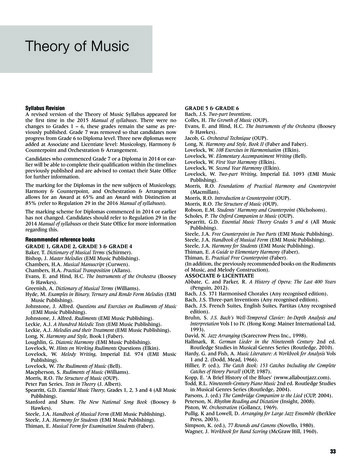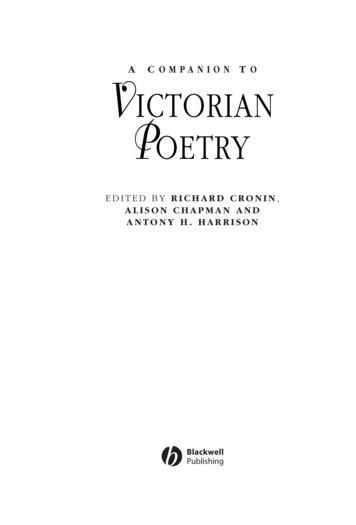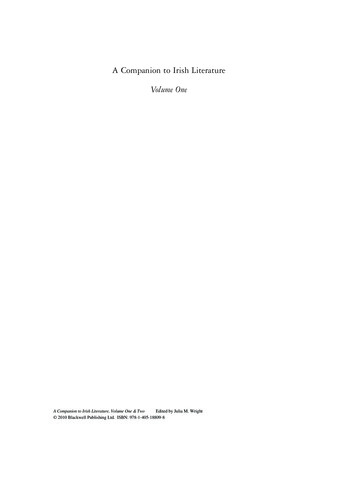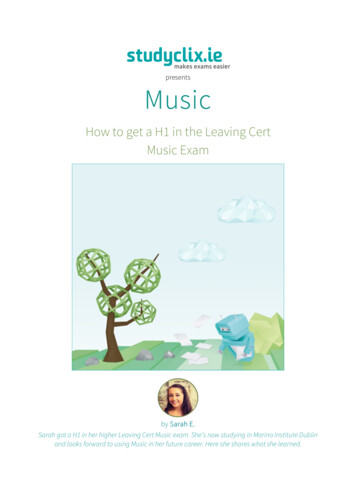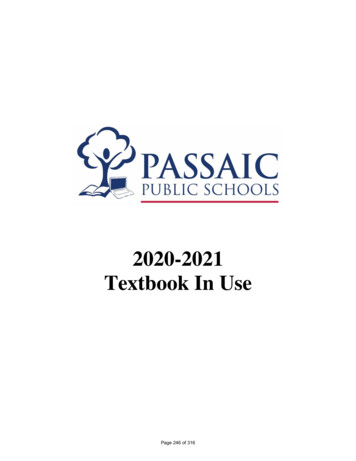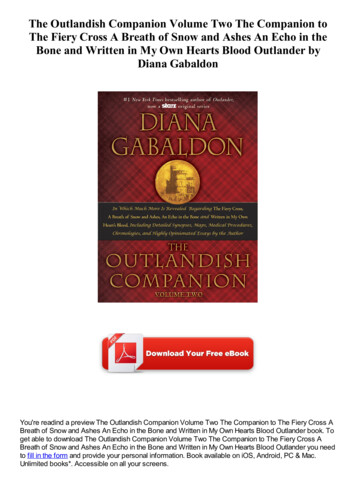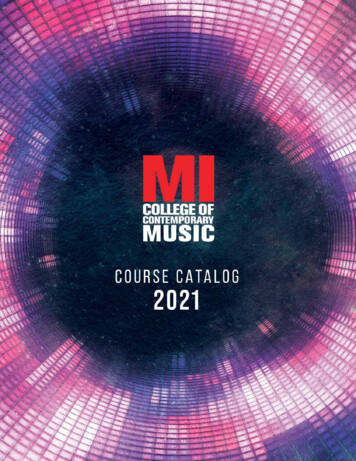
Transcription
The Praxis Study CompanionMusic: Content Knowledge5113www.ets.org/praxis
Welcome to the Praxis Study CompanionWelcome to the Praxis Study CompanionPrepare to Show What You KnowYou have been working to acquire the knowledge and skills you need for your teaching career. Now you areready to demonstrate your abilities by taking a Praxis test.Using the Praxis Study Companion is a smart way to prepare for the test so you can do your best on test day.This guide can help keep you on track and make the most efficient use of your study time.The Study Companion contains practical information and helpful tools, including: An overview of the Praxis tests Specific information on the Praxis test you are taking A template study plan Study topics Practice questions and explanations of correct answers Test-taking tips and strategies Frequently asked questions Links to more detailed informationSo where should you start? Begin by reviewing this guide in its entirety and note those sections that you needto revisit. Then you can create your own personalized study plan and schedule based on your individual needsand how much time you have before test day.Keep in mind that study habits are individual. There are many different ways to successfully prepare for yourtest. Some people study better on their own, while others prefer a group dynamic. You may have more energyearly in the day, but another test taker may concentrate better in the evening. So use this guide to develop theapproach that works best for you.Your teaching career begins with preparation. Good luck!Know What to ExpectWhich tests should I take?Each state or agency that uses the Praxis tests sets its own requirements for which test or tests you must take forthe teaching area you wish to pursue.Before you register for a test, confirm your state or agency’s testing requirements at www.ets.org/praxis/states.How are the Praxis tests given?Praxis tests are given on computer. Other formats are available for test takers approved for accommodations (seepage 51).The Praxis Study Companion2
Welcome to the Praxis Study CompanionWhat should I expect when taking the test on computer?When taking the test on computer, you can expect to be asked to provide proper identification at the testcenter. Once admitted, you will be given the opportunity to learn how the computer interface works (how toanswer questions, how to skip questions, how to go back to questions you skipped, etc.) before the testing timebegins. Watch the What to Expect on Test Day video to see what the experience is like.Where and when are the Praxis tests offered?You can select the test center that is most convenient for you. The Praxis tests are administered through aninternational network of test centers, which includes Prometric Testing Centers, some universities, and otherlocations throughout the world.Testing schedules may differ, so see the Praxis web site for more detailed test registration information at www.ets.org/praxis/register.The Praxis Study Companion3
Table of ContentsTable of ContentsThe Praxis Study Companion guides you through the steps to success1. Learn About Your Test.5Learn about the specific test you will be taking2. F amiliarize Yourself with Test Questions. 14Become comfortable with the types of questions you’ll find on the Praxis tests3. Practice with Sample Test Questions. 18Answer practice questions and find explanations for correct answers4. Determine Your Strategy for Success. 31Set clear goals and deadlines so your test preparation is focused and efficient5. Develop Your Study Plan. 34Develop a personalized study plan and schedule6. Review Study Topics. 38Detailed study topics with questions for discussion7. Review Smart Tips for Success. 49Follow test-taking tips developed by experts8. Check on Testing Accommodations. 51See if you qualify for accommodations to take the Praxis test9. Do Your Best on Test Day. 52Get ready for test day so you will be calm and confident10. Understand Your Scores. 54Understand how tests are scored and how to interpret your test scoresAppendix: Other Questions You May Have . 56The Praxis Study Companion4
Step 1: Learn About Your Test1. Learn About Your TestLearn about the specific test you will be takingMusic: Content Knowledge (5113)Test at a GlanceTest NameMusic: Content KnowledgeTest Code5113Time2 hours, divided into a listening section (Section 1) and a non-listening section(Section 2)Number of Questions120Pacing and SpecialIn Section 1 of the test, you are asked questions about recorded musical excerpts.During the audio portions, you are given time to read the questions and possibleanswers shown on the screen. A clock at the top of the screen shows you howmuch time is remaining to answer all of the questions in Section 1. You then have85 minutes to complete the 90 questions in Section 2.FormatSelected-response questions; 30 of the 120 questions are based on recordedmusical excerpts. This test will include questions with an audio component.Test DeliveryComputer deliveredContent CategoriesApproximateNumber ofQuestionsApproximatePercentage ofExaminationI. Music History and LiteratureCategory total:1815%IIIVSection 1 (listening*):9Section 2:9IIIIII. Theory and CompositionCategory total:19Section 1 (listening*):9Section 2:1016%III. PerformanceCategory total:2722%Section 1 (listening*):12Section 2:15IV. Pedagogy, Professional Issues, andTechnologyCategory total:5647%Section 1 (listening*):N/ASection 2:56*The questions in both Section 1 and Section 2 are counted in the main content categories I–IV.The special listening category counts only the questions (1–30) in Section 1. The special listeningcategory is intended to provide test takers with a potentially helpful breakdown of informationregarding the questions based on listening skills.The Praxis Study Companion5
Step 1: Learn About Your TestAbout This TestTest SpecificationsThe Music: Content Knowledge test is designedto assess a beginning music teacher’s knowledgeand understanding of music and music education.Examinees taking this test will typically havecompleted, or will have nearly completed, anundergraduate music education program. The testcontent assesses key indicators of the beginningeducator’s musical knowledge and professionalreadiness for K–12 music instruction requiredfor individuals teaching courses to students ininstrumental, vocal, or general music settings, orwho will teach courses drawn from any combinationof these three areas. Such knowledge is acquiredthrough completion of an undergraduate musiceducation degree program. The material in the test,therefore, is not appropriate for those hired in anadjunct capacity to teach a single element of thecurriculum (e.g., those hired to teach only individuallessons or classes on a single instrument).Test specifications in this chapter describe theknowledge and skills measured by the test. Studytopics to help you prepare to answer test questionscan be found on page 38.Materials appearing on the test reflect the diversityof examinees’ music instruction specialties as wellas the cultural and demographic inclusiveness ofmodern music instruction. These materials also reflectinstrumental (woodwinds, brass, percussion, andstrings), vocal, jazz, and general music instructionspecialties across the K–12 grade range. Questionsselected for the test represent an equitabledistribution of topics, including topics unique to eachspecialty as well as those that are common across allspecialties. Strategies for Teaching Technology, Carolynn A.Lindeman, ed. 2001 The National Association forMusic EducationThis test may contain some questions that will notcount toward your score.The nature and distribution of topics included on thetest were based on the results of a national surveygiven to music educators. Some of the resourcesconsulted in developing the survey include: National Association of School Music 2007–2008Handbook; http://nasm.arts-accredit.org/ Syllabi for Music Methods Courses, 2nd Edition 2002MENC–The National Association for Music Education,Barbara Lewis, University of North Dakota, ed. College Music Societyhttp://www.music.org Society for Music Teacher Education; http://smte.us/ Interstate New Teacher Assessment and SupportConsortium Performance Standards for Music, Grades PreK–12, Paul R.Lehman, chair. 1996 Music Educators NationalConferenceA nationally representative panel of music educatorswas convened to study the survey results and assistETS’s professional assessment staff in determiningthe distribution of topics on the test. Each ETSassessment specialist working on this test hasextensive experience in music education. Additionally,ETS assessment specialists consult regularly withmusic teachers and music education professors fromthroughout the country to ensure the appropriatenessof individual test questions and the validity of eachnew test edition.The following is an outline of the topics coveredon the test. Question content is based specificallyon practitioners’ judgments of what a new musicteacher should know in order to begin a career as amusic education professional. The bulleted phrasesare included as examples of representative questioncontent one may see on the test. Additional topicsmay also be included as appropriate.The Praxis Study Companion6
Step 1: Learn About Your TestSection 1: Listening Section2. Theme and melodyI. Music History and Literature3. Rhythm, meter, and tempoA.Understands the history of majordevelopments in musical style and thesignificant characteristics of importantmusical styles and historical periodsa.4. Form and structure5. TextureB.1. Styles and historical periods represented roqueClassicalRomanticImpressionismEarly 20th CenturyMid 20th Century to presentJazz, rock, folk, and other popular genrese.f.g.h.i.j.B.melodyharmonyrhythm and metertempi, dynamics, and other expressiveelementstexturetheory and compositional organizationforms and genreshistorical contextsrepresentative composersrepresentative ensembles and performers2. DynamicsIII. PerformanceA.Demonstrates critical listening skills byidentifying errors in1. Pitch2. Intonation of instruments and voicesa.b.c.tuning students on individual instrumentstuning between two or more performersvowel uniformity3. Rhythm4. Performing as a unified section/ensemble5. Balance and blend6. Articulations7. DynamicsB.Understands basic conducting techniques1. Beat patterns2. Use of the baton and freehand technique3. Eye contact and facial expressionsIs familiar with the style of a variety of worldmusics and their function in the culture oforigin4. Tempo and tempo changes5. Attacks, holds, and releases1. North America6. Dynamics and expressive gestures2. South America3. EuropeUnderstands how musical sounds vary1. Timbre of instruments and voices2. Characteristics of music related to style andperioda.b.c.d.contour and motive7. Cueing5. Australia and the PacificUnderstands the interpretation of notationand expressive elements for performance inrelation to score markings and style periods6. Asia1. Interpreting musical symbols used for pitch4. AfricaC.2. Interpreting musical symbols used for rhythmII. Theory and CompositionA.Understands and analyzes music in aural formand demonstrates aural skills throughrecognition of melody, harmony, and rhythm1. Pitch organization and harmonya.b.chords, progressions, ornamentationmodes, scales, tone rows, etc.The Praxis Study Companion3. Dynamic markings4. Articulation markings5. Tempo markings6. Composers’ written comments7. Timbre7
Step 1: Learn About Your TestD.Understands basic accompanimenttechniques (e.g., on piano, guitar, voice)1. Identifying appropriate harmonies toaccompany tonal melodiesII. Theory and CompositionA.Understands, interprets, and analyzes music inwritten form1. Pitch organization and harmony2. Basic accompanying patterns (e.g.,arpeggiation, block chords, ostinato)a.b.chords, progressions, ornamentationmodes, scales, tone rows, etc.Section 2: Non-Listening Section2. Theme and melodyI.3. Rhythm, meter, and tempoa.Music History and LiteratureA.Understands the history of majordevelopments in musical style and thesignificant characteristics of importantmusical styles and historical periods4. Form and structure5. Texturea.b.c.d.1. Styles and historical eClassicalRomanticImpressionismEarly 20th CenturyMid 20th Century to presentJazz, rock, folk, and other popular genrese.f.g.h.i.j.B.a.b.B.1. North America2. South AmericaC.timbre of instruments and voicesdynamicsKnows and applies basic music theoryconcepts when composing, orchestrating, andarranging instrumental and vocal parts1. Chords and voice leading2. Ranges and transpositionsmelodyharmonyrhythm and metertempi, dynamics, and other expressiveelementstexturetheory and compositional organizationforms and genreshistorical contextsrepresentative composersrepresentative ensembles and performersIs familiar with world musics and theirfunction in the culture of originmonophonichomophonicpolyphonicheterophonic6. How musical sounds vary2. Characteristics of musica.b.c.d.contour and s3. Balance4. Instrumentation and voicing of ensembles5. Functions of instruments and voices within ascore6. Expressive elementsIII. PerformanceA.Understands basic conducting techniques3. Europe1. Beat patterns4. Africa2. Use of the baton and freehand technique5. Australia and the Pacific3. Eye contact and facial expressions6. Asia4. Tempo and tempo changesKnows various sources of printed andelectronic information on music history andliterature5. Attacks, holds, and releases6. Dynamics and expressive gestures7. Cueing1. Books2. Journals and periodicals3. Web resourcesThe Praxis Study Companion8
Step 1: Learn About Your TestB.Understands the interpretation of notation andexpressive elements for performance in relationto score markings and style periodsG.1. Interpreting musical symbols used for pitch1. Developing program notes and educationalmaterials for specific purposes and audiences2. Interpreting musical symbols used for rhythm3. Dynamic markings2. Appropriate remarks in performance situations4. Articulation markings3. Techniques of developing appropriatepublicity for the music program and for eventstaking place in the music program5. Tempo markings6. Composers’ written comments4. Appropriate etiquette for various types ofperformance venues7. TimbreC.Knows a variety of strategies on how toprepare a musical score for rehearsal andperformanceH.1. Sound production2. Score research2. Tone quality3. Interpretive decisions3. Rehearsal and performance spaceconfigurations and setups4. Reverberation, sound reflection, refractionKnows instrumental and choral/vocal warm-uptechniques5. Frequency1. Breathing6. Amplitude, sound amplification2. Physical warm-ups (e.g., stretching, posture)7. Harmonics, partials, overtones3. Technical warm-ups (e.g., scales, arpeggios,chorales, vocalises)E.Knows instrumental and choral tuning/intonation techniques1. Instrumental techniquesa.b.IV. Pedagogy, Professional Issues, andTechnologyPedagogyA.tuning students on individual instrumentstuning between two or more performersa.b.c.a.b.c.d.e.lifting the palatevowel uniformitybreath support and body postureUnderstands basic accompaniment techniques(e.g., on piano, guitar, voice)full-ensemble rehearsalssectional and small-group rehearsalsindividual lessonsrehearsal planningrehearsal strategies2. Elementary and secondary general musica.b.c.1. Identifying appropriate harmonies toaccompany tonal melodies2. Basic accompanying patterns (e.g.,arpeggiation, block chords, ostinato)Knows instructional strategies for different classsettings1. Performance classes2. Choral/vocal techniquesF.Understands the practical relationship betweenacoustics and performance1. Score study4. Score markingD.Understands concert etiquette for performersand audiences and effective techniques forcommunicating with an audience in aperformance settingB.full classsmall grouplabs and independent projectsIncorporates local, state, and national standardsin planning and instruction1. Recognizes importance of linking pedagogy toappropriate standards2. Ability to evaluate degree to which instructionlinks to standardsThe Praxis Study Companion9
Step 1: Learn About Your TestC.Understands classroom management techniques5. Assessing individual and group performanceskills1. Physical classroom environment6. Appropriate classroom assignment gradingcriteria2. Rules and consequences3. Appropriate actions to take for given situations7. Appropriate course grading practices4. Legal implications5. Planning and pacing8. Formative assessment—uses in guiding andevaluating students’ progress6. Procedures and routines9. Assessments’ role in program evaluation7. Principles of motivation applied to the musicclassroom10. Taxonomies of xtrinsic11. Techniques to evaluate the effectiveness ofmusic curriculaUnderstands how to plan and differentiateinstruction1. How the distinguishing characteristics ofstages of student growth and developmentaffect music learninga.b.c.a.H.physicalcognitivesocial1. Diverse genres2. Appropriate performance competencies forstudents’ developmental levels3. Lesson and unit planninga.b.c.d.e.f.4. Student abilityKnows strategies to accommodate diverselearning styles and abilities1. Aural learners2. Visual learners4. Community traditions and standardsUnderstands how to modify instruction toaccommodate student needs5. State and local guidelines6. Quality of literature1. Students with disabilitiesa.b.c.d.7. Knows appropriate sources of nala.b.c.d.2. Other student needsa.b.c.G.culture and beliefsgifted studentsEnglish-language learnersUnderstands a variety of assessment strategiesthat inform the instructional processprimaryelementarymiddle schoolhigh schoolvocal rangesinstrumental ranges and transpositions3. Cultural diversity3. Kinesthetic learnersF.Understands how to select appropriaterepertoire for the classroom and for performanceensembles with respect to a variety of factorsSelecting music with respect to2. Scope and sequenceE.program evaluation (e.g., goals andobjectives, scope and sequence)I.Lists of recommended repertoireConferencesColleagues and mentorsPublisher resourcesKnows how to teach vocal production andperformance techniques with respect to a varietyof factors1. Vocal mechanism1. Use of standardized tests for measuringaptitude and achievement2. Health and wellness issues for vocalists2. Portfolio assessment4. Tessitura3. Changing voice3. Multiple-choice testing4. Assessment using scoring rubricsThe Praxis Study Companion10
Step 1: Learn About Your TestJ.Knows instrumental techniques (e.g., rudiments,bowings, embouchures) and how to teach themM.1. WoodwindCare of instruments2. String (includes guitar)1. Woodwinds3. Brass2. Strings (including guitar)4. Percussion3. Brass5. Keyboard4. Percussion and keyboards6. General classroom instruments5. Classroom instruments (Orff and rhythminstruments, recorders)7. Health and wellness issues for instrumentalistsK.6. Electronic instrumentsIs able to address common vocal andinstrumental performance challenges and theircausesCare of materials7. Printed material (books, music, scores)1. Reading pitches and rhythms2. Balance and blend8. Recorded material (CDs, electronic files such asMP3s)3. Intonation9. Risers and stands4. Technical challenges10. Audiovisual and computer equipment5. Style and interpretationL.Knows and promotes care and maintenance ofinstruments and materialsN.Is familiar with common pedagogical approaches6. Physical causes1. Suzuki7. Comprehension causes2. DalcrozeUnderstands organization and preparation ofconcert programming3. Kodály1. Diversity of repertoire (includes considerationof vocal texts)5. Edwin Gordon’s Music Learning Theory4. Orff Schulwerk6. Comprehensive Musicianship2. Consideration of difficulty levels with regard toavailable preparation and rehearsal time7. Laban8. Phyllis Weikart3. Concert pacing and endurance issues4. Programming considerations relative to specialoccasions and specific performance venuesO.Understands strategies for developing sightreading skills5. Pedagogical philosophies related toprogramming1. Solfège and other systems6. Awareness of consideration of building leveland district expectations with regard toconcert programming3. Mental practice and scanning methods7. Concert logistics planning (scheduling,facilities, publicity, communication withstudents/parents/administrators, printingprograms)The Praxis Study Companion2. Audiation of pitch, interval, and rhythmP.Knows basic improvisational techniques andhow to teach them1. Imitation2. Variation3. Improvisational techniques within variousstyles11
Step 1: Learn About Your TestQ.Knows basic composition and arrangingtechniques and how to teach themV.Is familiar with the music standards in theNational Core Arts Standards1. Activities leading to composition (e.g.,improvisation, completion exercises)W.Is aware of professional organizations andresources in music education2. Pitch and rhythmic organization techniquesR.3. Form1. Local, state, and national teacher and musicteacher organizations4. Style2. Mentors and colleagues5. Thematic construction3. Books, journals, and periodicals6. Harmonization, accompaniment, and imitation4. Reference works and Web resources7. Vocal and instrumental rangesX.Knows how to teach a variety of musicalconcepts through performance literatureIs aware of current trends and issues in musiceducationY.1. Elements of music (e.g., melody, harmony,rhythm, form, timbre, texture) and expressiveelementsIs aware of the major contributions to thehistory and philosophy of music educationand their implications for curriculumZ.2. Music theoryUnderstands philosophical reasons forinclusion of and advocacy for music in thecurriculum3. Music history1. Utilitarian (e.g., comprehensive education)4. Music in relation to other subjects2. Aesthetic (e.g., affective education)5. Musical creativity and the aesthetics of musicS.Is aware of approaches for fostering musicallyexpressive experiences1. MentoringFostering musical expression in2. Collegiality1. Performance3. Inclusion (e.g., Individualized EducationPrograms [IEP], students with special needs)2. Improvisation3. CompositionTechniques to teach aesthetics4. Guided listening5. Analysis, reflection, evaluation6. ModelingT.AA. Recognizes that collaboration with colleaguesis important for implementing the curriculumUnderstands how to integrate concepts used inthe fine arts and other disciplines in musicinstruction1. Music integrated with other subjects in thefine arts2. Music integrated with subjects outside of thefine artsAB. Supports students’ learning through two-waycommunication with parents/guardiansFormal and informal:1. Parent-teacher conferences2. Telephone3. Written communications, including e-mail anddepartmental web sitesAC. Understands basic administrativeresponsibilities in a music program1. Budget maintenance2. Inventory3. SchedulingProfessional IssuesU.Understands professional ethics and legal issuesspecific to teaching music1. Copyright laws2. Confidentiality3. Appropriate professional conductThe Praxis Study Companion12
Step 1: Learn About Your TestAD. Is aware of the external influences that affectthe music program, curriculum, and studentparticipationAI. Demonstrates knowledge of desktop musicpublishing software for pedagogical purposes1. Input1. Scheduling2. Output2. Mandates3. Playback3. Budget constraints4. Posting4. Advocacy groups5. Student and community economics anddemographicsAE. Is aware of career opportunities available inmusic and how to introduce them to students1. Performance2. Business3. Education4. TechnologyAJ. Knows the appropriate, ethical, and safe usesfor music software and Internet technologies1. Educational2. Interactive3. Internet posts4. Filtering software5. Copyright6. Health and wellness issues related to use oftechnology5. MedicalAF. Is aware of strategies for promoting physicallyhealthy performance practices for studentsand teachers1. Hearing protection2. Health issues specific to teachers (e.g., usingthe voice in the classroom, work-related stress)TechnologyAG. Understands current technologies used forperformance and recording production1. Sound reinforcement2. Analog, digital, and MIDI equipment3. Virtual instrumentsAH. Is familiar with technology and instructionalsoftware and ways to incorporate them in theclassroom1. Hardwarea.b.c.d.e.cables and audio interfacesmicrophonesmusic storage devicesspeakers and monitorstablets2. Softwarea.b.c.d.e.f.g.cloud-based storagemusic assessment softwaremusic digital audio workstationsoftwaremusic notation softwaremusic pedagogy softwaremusic streaming applicationspresentation software3. MultimediaThe Praxis Study Companion13
Step 2: Familiarize Yourself with Test Questions2. Familiarize Yourself with Test QuestionsBecome comfortable with the types of questions you’ll find on the Praxis testsThe Praxis assessments include a variety of question types: constructed response (for which you write aresponse of your own); selected response, for which you select one or more answers from a list of choices ormake another kind of selection (e.g., by clicking on a sentence in a text or by clicking on part of a graphic); andnumeric entry, for which you enter a numeric value in an answer field. You may be familiar with these questionformats from taking other standardized tests. If not, familiarize yourself with them so you don’t spend timeduring the test figuring out how to answer them.Understanding Computer-Delivered QuestionsQuestions on computer-delivered tests are interactive in the sense that you answer by selecting an optionor entering text on the screen. If you see a format you are not familiar with, read the directions carefully. Thedirections always give clear instructions on how you are expected to respond.For most questions, you respond by clicking an oval to select a single answer from a list of answer choices.However, interactive question types may also ask you to respond by: Clicking more than one oval to select answers from a list of choices. Typing in an entry box. When the answer is a number, you may be asked to enter a numerical answer.Some questions may have more than one place to enter a response. Clicking check boxes. You may be asked to click check boxes instead of an oval when more than onechoice within a set of answers can be selected. Clicking parts of a graphic. In some questions, you will select your answers by clicking on a location (orlocations) on a graphic such as a map or chart, as opposed to choosing your answer from a list. Clicking on sentences. In questions with reading passages, you may be asked to choose your answers byclicking on a sentence (or sentences) within the reading passage. Dragging and dropping answer choices into targets on the screen. You may be asked to select answersfrom a list of choices and drag your answers to the appropriate location in a table, paragraph of text orgraphic. Selecting answer choices from a drop-down menu. You may be asked to choose answers by selectingchoices from a drop-down menu (e.g., to complete a sentence).Remember that with every question you will get clear instructions.Perhaps the best way to understand computer-delivered questions is to view the Computer-delivered TestingDemonstration on the Praxis web site to learn how a computer-delivered test works and see examples ofsome types of questions you may encounter.The Praxis Study Companion14
Step 2: Familiarize Yourself with Test QuestionsUnderstanding Selected-Response QuestionsMany selected-response questions begin with the phrase “which of the following.” Take a look at this example:Which of the following is a flavor made from beans?(A) Strawberry(B) Cherry(C) Vanilla(D) MintHow would you answer this question?All of the answer choices are flavors. Your job is to decide which of the flavors is the one made from beans.Try following these steps to select the correct answer.1) L imit your answer to the choices given. You may know that chocolate and coffee are also flavors madefrom beans, but they are not listed. Rather than thinking of other possible answers, focus only on the choicesgiven (“which of the following”).2) E liminate incorrect answers. You may know that strawberry and cherry flavors are made from fruit andthat mint flavor is made from a plant. That leaves vanilla as the only possible answer.3) V erify your answer. You can substitute “vanilla” for the phrase “which of the following” and turn thequestion into this statement: “Vanilla is a flavor made from beans.” This will help you be sure that your answeris correct. If you’re still uncertain, try substituting the other choices to see if they make sense. You may wantto use
The Music: Content Knowledge test is designed to assess a beginning music teacher’s knowledge and understanding of music and music education. Examinees taking this test will typically have completed, or will have nearly completed, an undergraduate music education program.
